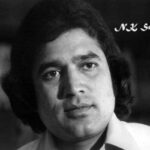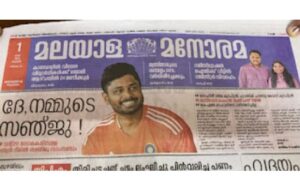Veteran journalist recalls his visit in the year 2008 to the site near the south Indian city of Bengaluru where the iconic film was shot (then called Bangalore)
 By Lakshmana Venkat Kuchi
By Lakshmana Venkat Kuchi
@kvlakshman
The pictures you see of mine walking on the same rocks, in the same spot as did Gabbar and entered the psyche of every Indian film watcher, are now extremely difficult, or even impossible to get again.
Yes, my ‘pilgrimage’ was complete when I visited the spot and the site where iconic Sholay – also the first film I saw bunking school at Priya cinema in South Delhi in 1975 and got caught at home — was shot and was in the making for nearly two years at Ramanagara, some 40 km from Bengaluru, widely regarded as the ‘Silicon Valley of India’ (or ‘IT capital of India’).
But why is getting similar pictures not only difficult but nearly impossible today? Even the thought, of this impossibility, leaves us a tad sad, isn’t it? After all, which cinema lover can forget the scene when Gabbar (Amjad Khan) enters the frame of the film with his belt clanging on the boulders he is walking on, wearing a cruelly angry scowl on his face and an intense look on his face?


Why getting similar pictures is almost impossible today
There are two reasons why getting similar pictures is nearly impossible today – firstly, unlike circa 2008 when I spent nearly a day at the Sholay site renamed Ramgarh where director Ramesh Sippy erected an entire village for two years only to dismantle it after completing the film, today any chance of trekking up to Gabbar’s den nestled amidst huge rocky mountainous terrain is not possible as it has been fenced off by a private firm that has had plans to build a tourist resort there.
One can still drive up to near a temple located closer to the den at the foothills (so to speak) of the steep and upwardly path that snake through the wild bushy, thorny vegetation, but no further.
But if no resort has come up there yet, it is thanks to the environmental activists who blocked the project through legal means, challenging the permission to build structures that could impact ecological and environmental balance as the area around hosts the country’s first vulture sanctuary at Ramdevara Betta. The sanctuary, spread around 346 hectares, aims to revive and protect the fast-dwindling population of long-billed vultures, an endangered species in the world. Since the issue is tied up in courts, the resort plan has got stuck.

Super Expressway
The second reason, as to why the Sholay site may never be the same again, is that the Karnataka government has permitted the construction of Bengaluru-Mysuru super expressway that skirts the shooting site. This cuts through some of the area that was used for filming a few scenes in the film.
However, the area that hosted ‘Ramgarh’ is largely intact although locals fear ‘development’ along the expressway could have its own adverse impact on the ‘historicity’ of the site. So, selfishly speaking, these two factors make me the proud owner of the “self-Gabbarish” portraits snapped by a digital camera that I could manage to get to the spot through a photographer when I was touring Karnataka to report on State assembly elections being held then in 2008.
I cannot explain the feeling when the “mount-Everest” conquering moment came true for me – that I was actually walking on the same boulder on which walked the great Gabbar!
Why they called me Gabbar!
Why, I was even called ‘Gabbar Singh’ by colleagues back in Delhi offices of Hindustan Times where I was working because of my unending renditions of unalloyed, happy and joyful experiences with and in the Sholay-land.

For me, it was a long-awaited pilgrimage to Ramgarh and to pay tributes to the makers of Sholay. I was tingling with excitement at the moment I sneaked through a small opening among the bushes and stepped onto the small open space encircled by huge boulders that served as Gabbar’s “operational headquarters” or the den. For sure it was the kitne aadmi the (how many people were there?) moment for me – the three words Gabbar spews out in questioning three members of his gang.
It took me some effort to climb up to den, but for villagers who live and breathe every moment of their life associated with the film, it was an easy routine.
Climbers’ Paradise
Not far from Gabbar’s den is an area that has become a climbers’ paradise and groups of enthusiasts gather there on weekends.
Gabbar’s den, created on an open space encircled by huge boulders, was just perfect as he could post sentries like the most-famous sidekick, Sambha, to look out for any trouble sitting atop the tallest boulder and get the best 360-degree scan anyone could get from there.
The villagers of Ramanagaram, among them a couple of “bit-role actors”, are convinced that a Sholay can never be made again. Coming to think of it, actually, a happy accident like that can only happen once-in-a-long-time. Every actor in the film was an exact fit for the role, whether the two-minute cameo of Jagdeep as Soorma Bhopali or that of Asrani as the Jailor, the music, the screenplay and the sound system all combined to present a mindboggling impact on the viewers. The impact remains the same even today.
Sholay is a film that has a cross generation appeal, in the making of which the makers got hold of a few Western classics from Hollywood and mixed them into a desi version complete with song and dance sequences. After running to empty houses for nearly two weeks when the film was released in 1975, it began picking up on word of mouth.
Nostalgic Journey
I still remember the two “pre-recorded film dialogues and songs cassettes” that I bought, to relive the film at every available opportunity at home. Now one tends to get into a nostalgic journey of that tape recorder, Japanese of course, unless one got a duplicate from Lala Lajpat Rai Market opposite the Red Fort. And to add to the list back then – roadside eating, goodies from kanche, gulli danda, lattus, as any Delhite (resident of Delhi) of my generation – I am 62 right now – would remember. Sorry for digressing, but then nostalgia is such a thing.

The nostalgic in me concurred with the Ramnagara villagers that Sholay can never be made again. Period. Bollywood attempted remake of Sholay but the film ended up as a disaster – also for the superstar Amitabh Bachchan who donned the hat of Gabbar this time.
When Ramgarh set was demolished
Cut to the original one. Three months after the making of Sholay, the entire Ramgarh set was demolished. Not a trace remains other than the boulders and rocks and hillocks that dot the area. Gabbar’s den too is in a disheveled state.
Locals point out the spots they remember. A tree now stands at the spot where Veeru (Dharmendra) climbs up the water tank and reads out his suicide note to villagers while seeking Basanti (Hema Malini) by hook or by crook. The pond where Basanti waits for Veeru still has some water in it. Adjacent to the pond is a hillock where there was a temple where Basanti prays for a good husband. There stands a huge boulder that witnessed it all.
Amidst ‘Real’ People
I enjoyed every moment I spent with the real people who had witnessed the making of Sholay. Some even helped in the making of the set and participated in scenes where crowds were required. Their association with the film unit for five years proved beneficial to them as well.
As a 17-year-old boy back then, Goni Siddhaiah, now 62, used to make 5 to 10 paise in tips a day. His parents were daily wagers on the sets earning Rs 5 a day then, a tidy sum at that time. At least 50 villagers had helped in the making of the iconic film, Siddhaiah told me.
Similarly, Masons Javed and Amjad were taken to Mumbai and did well for themselves.
Networking too paid off, as a couple of them became businessmen.
There are many like Siddaiah. Young boys from the village turned tourist guides to people coming to have a look at the Sholay sites.
“We all gather, and watch film now and then relive those memories,” said a villager.
A young boy shouted out to me: “That is the rock where Sambha (Mac Mohan) used to sit and this is where Basanti danced on broken glasses. It was there that Gabbar had Thakur Baldev Singh (Sanjeev Kumar) tied up before he chopped off his hands.”
It was a day well spent for me as I bid adieu to the “real Sholay stars” and drove back to Bangalore, still immersed in the joyful happiness of a pilgrim who had just had the darshan – of a seeker who got what he sought, in life.












More Stories
When Rajesh Khanna left the shoot mid-way, told scribe, ‘I’m going for a screw’
Of the Northern Lights and an Adventure with Huskies in Swedish Lapland!
Sufiana Lived His Heart: A Daughter Reminisces